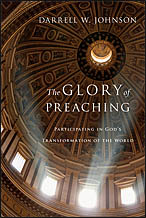Darrell Johnson, The Glory of Preaching
 Darrell W. Johnson, The Glory of Preaching: Participating in God’s Transformation of the World (IVP Academic, 2009), 278 pages, ISBN 9780830838530.
Darrell W. Johnson, The Glory of Preaching: Participating in God’s Transformation of the World (IVP Academic, 2009), 278 pages, ISBN 9780830838530.
With the massive growth in multimedia ministries, it might seem that preaching could go the way of vinyl LPs and telegrams. However, in The Glory of Preaching, Darrell W. Johnson not only aims to convince us that preaching has not lost any of its wonder but that, by standing up to preach, we have the opportunity to participate in this wonder each and every week.
In part 1, we are given the theoretical reasons behind the importance of preaching, based on his hypothesis that “When a human being … invites the gathered assembly into a particular text of the Bible … something always happens” (p. 7). The first two chapters of this part take the form of extended expositions of two key Bible chapters, Ezekiel 37 and Matthew 13. Taken together, these two chapters not only give us a glimpse of the redemptive power of preaching but of reasons why we may not see the expected results after every sermon. The fourth chapter takes a different angle by providing a useful and inspiring study of the Greek words used to refer to preaching and the dynamics of the preaching moment that they represent.
The only flaw in this section is that, whereas three of the four chapters rely on direct examination of the Word of God, the third chapter takes a more indirect route and focuses exclusively on the views of theologians. While theological reflection on preaching is welcome and necessary, it would have been useful to relate the theological positions to biblical examples. The thesis of this chapter is that expository preaching, where a sermon examines a single biblical text, rather than a theme or principle, is superior to other preaching methodologies such as narrative and topical preaching (pp. 53-55). Such a position is surely hard to defend scripturally, given the wide variety of preaching styles used by both Jesus and His disciples.
For a number of readers, part 2 will be welcomed as one of the most straightforward sections of the book to apply to the practice of preaching. Here the author deals with the mechanics (his term, see pp. 103-104) of creating a sermon from a Biblical text and backing up your words with Biblical integrity.
In the first chapter of this section (chapter 5), the author walks us through the broad steps of sermon creation from scripture selection to finding the right ways to express the sermon’s content. For each step in the process, we are given a number of questions to guide our thinking. Of course, some of these will be more relevant to some texts and even congregations than others. For instance, the precise nuances of the prepositions used in a text may be less relevant when preaching to a church with a large proportion of new believers. However, these guides, if used wisely will give any preacher an excellent foundation for text study.
Chapter 6 moves us to the ordering of the sermon by providing a wide range of sample structures that can be used. These will be useful for both inexperienced and mature preachers alike and, when combined with the study methods outlined in the previous chapter will form a powerful addition to a preacher’s toolkit. We are also reminded of the oral nature of preaching and the effects this might have on preparation and on the creation of the notes that are taken up to the pulpit.
Category: Ministry, Summer 2010


